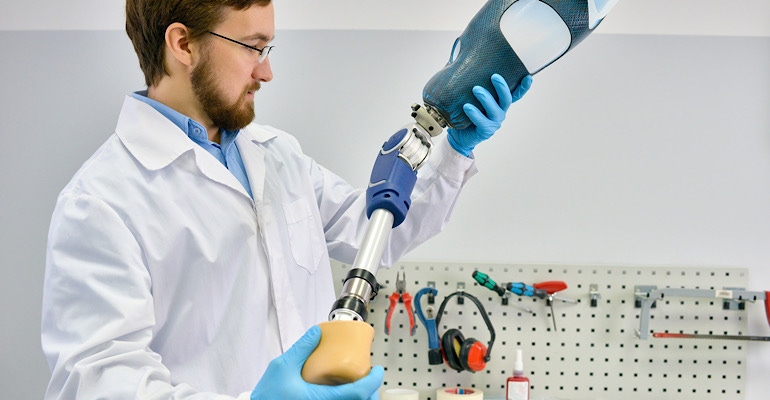Selecting a Debinding Fluid for 3D Printed Components
The most common use of metal 3D Printing is to make simple manufacturing support items like jigs, fixtures, and other machine tooling. But it is also used for small-volume runs of very complex parts and intricate surgical instruments.
August 28, 2020

Venesia Hurtubise
Metal 3D printing, a subset of additive manufacturing, is gaining traction with medical device manufacturers today. They use metal 3D Printing in a variety of ways. The most common is to make simple manufacturing support items like jigs, fixtures, and other machine tooling. But it is also used for small-volume runs of very complex parts and intricate surgical instruments. Or to make highly-customized medical devices such as bone grafts, orthotics, and prosthetic limbs. In addition, device makers turn to metal 3D printing when security is a concern. Rapid in-house 3D prototyping, means device designs are never publicly shared, helping to ensure the confidentiality of their innovative new designs.
There are many types of metal 3D printing methods used today. However, many designers choose binder jetting because it is less expensive, faster, and easier-to-use than other methods. Binder jetting builds a part out of fine metal powders and binders. It creates the part on a powder bed by depositing alternating layers of metal powder and binders. The part builds, in thin horizontally progressive layers, until it reaches its final shape.
A variety of metal powders including medical grade stainless steel, low alloy steels, carbon steels, Ni-alloys, tool steels, and tungsten alloys are used to build small, precise, and detailed medical devices and surgical instruments. Common types of binders are paraffin wax, carnauba wax, and specialty polyethylene waxes.
The binders help form the metal powder into a specific shape. However, the binders are temporary. Only a very small amount of binders must stay inside the part to keep it from deforming and cracking during sintering. The rest of the binders are carefully removed to allow for faster sintering. Removal of the binders typically reduces the sintering time from days to mere hours. Successful part debinding is a balance of selectively removing the right amount of binders as quickly as possible without damaging the fragile part.
The part is thermally sintered at near melting temperature. This burns off any remaining binders and bonds the metal powder to its solid mass state, typically 96-99.8% density. After that, the part is post-processed using standard finishing techniques like sanding, painting, or coating.
In some shops, part debinding typically happens inside a vapor degreaser using a specialty debinding fluid. Dunking a part into the fluid or holding it inside the fluid vapors, dissolves the binders and transports them away from the part.
Part debinding is a straightforward process. However, it is important to get the details right for the best possible end product. The debinding fluid must discriminately remove some of the binders, but not all, to ensure the part maintains its structural integrity. To achieve this, the physical properties of the debinding fluid are important. Here is what to look for:
Debinding fluid performance
Low viscosity: Less viscous fluids flow around and into the metal part more easily for more complete debinding.
Low surface tension: Low surface tension allows the fluid to work its way into the part, especially inside tight, internal geometries to remove the binders.
Correct strength: The debinding fluid should be aggressive enough to selectively remove the right amount of binders yet still maintain the part’s integrity.
Good materials compatibility: The debinding fluid should be safe to use both with the metal powders and the binders to safeguard the formed part.
Fast evaporating: A fast evaporating debinding fluid ensures no gasified binders are left behind in the part. Remaining fluid inside the part could result in cracking, deformation or part expansion during sintering. Plus, a fast-evaporating debinding fluid means the metal part dries quicker, resulting in faster production times.
Low boiling: Low boiling debinding fluids still melt the wax binders but do not damage the non-soluble fragile part. Plus, it allows the vapor degreaser to run more efficiently. It also shortens the vapor degreaser start up time, lowering overall energy use and costs.
Maintenance-free: Modern debinding fluids do not require stabilizers, scavengers, or weekly acid acceptance testing to sustain their integrity, reducing maintenance time and costs.
Debinding fluid safety and compliance
Low toxicity: Modern debinding fluids do not use n-propyl bromide, methyl pyrrolidone, polyethylene glycol, heptane, or trichloroethene which all carry serious health and or environmental concerns.
Nonflammable: Nonflammable debinding fluids are safer for workers and do not require specialty fire or explosion-proof equipment.
Regulatory compliance: Most modern debinding fluids are not a hazardous air pollutant (HAP). Many do not require National Emission Standards for Hazardous Air Pollutants (NESHAP) permits.
Safe for workers: The PEL (Permissible Exposure Limit), or OSHA-designated time limit that workers are exposed to a solvent, is about 200-250 ppm for modern debinding fluids. This is significantly better than TCE (100-ppm PEL) or nPB (0.1 ppm PEL).
Environmentally sustainable: Most modern debinding fluids have a low GWP (Global Warming Potential) under 10 and a zero Ozone Depleting Potential (ODP). This makes them better for overall air quality. Choosing an environmentally sustainable debinding fluid helps companies not only meet regulations today but prepares them to comply with evolving future regulations. In addition, when used in a vapor degreaser, modern debinding fluids are distilled, recycled, and reused, limiting environmental waste.
Metal 3D printing for the future
Metal 3D printing is changing quickly. Until recently it was used just for prototyping or low-volume runs because it was too expensive and too slow for mass production. But as a wider selection of part materials become available and as new software and hardware evolve, more companies are using metal 3D printing for higher production runs of medical devices. In addition, using modern debinding fluids brings operating efficiencies, cost savings and better environmental sustainability to the metal 3D printing processes of the future.
Work with an Expert
Debinding fluid is an important tool for successful 3D printed medical device manufacturing. Fortunately, there are a number of good modern debinding fluid choices that not only debind effectively but are also safer for people and gentler on the planet. Companies looking for help in determining the right debinding fluid or method should consult with a critical cleaning partner that specializes in vapor degreaser debinding. Some fluid manufacturers have field engineers that conduct on-site audits to evaluate debinding methods and can also perform comprehensive in-lab tests with sample parts to ensure which debinding fluid works best.
Venesia Hurtubise is a Technical Chemist at MicroCare Medical which offers medical device cleaning, coating, and lubricating solutions. She has been in the industry for more than 5 years and holds an MS in Green Chemistry from Imperial College London. Hurtubise researches, develops, and tests cleaning-related products that are used on a daily basis in medical and precision cleaning applications. For more information, visit www.microcaremed.com.
You May Also Like


